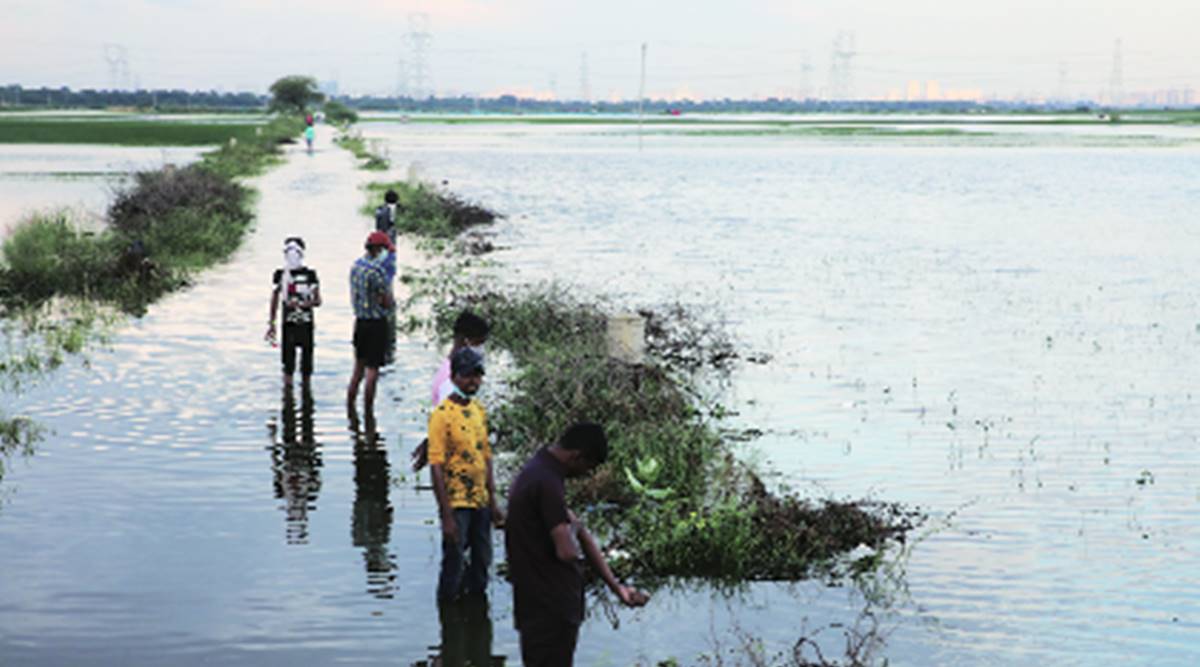 100 acres of Rawta’s farmland is submerged for most of the year. (Photo: Abhinav Saha)
100 acres of Rawta’s farmland is submerged for most of the year. (Photo: Abhinav Saha)The Delhi government is planning to restore Najafgarh lake and augment the city’s water supply by leasing farmers’ lands and building ponds to recharge the groundwater table at Southwest Delhi’s Rawta village. The proposed project is similar to the one it is undertaking at North Delhi’s Palla, where a 25-acre pond, up to a depth of 1.7 metres, was created on the Yamuna floodplains to recharge groundwater through overflow from the river.
About 100 acres of Rawta’s farmland close to the Najafgarh drain, which officials said constitute the lake, is submerged for most part of the year by overflowing drain water. This has impacted farmers’ income and led them to stage protests, one even recently seeking Chief Minister Arvind Kejriwal’s intervention.
The government has now proposed to take this land on lease from farmers for Rs 77,000 per acre, with an increment of 7% per annum, and use it to restore the lake and also augment the city’s water supply by around 40 million gallons per day (MGD).
The proposal was made by Minister for Flood and Irrigation Satyendar Jain and Matiala MLA Gulab Singh at a meeting held on October 17 with farmers from the village, an official at the meeting told The Indian Express. “Villagers couldn’t reach a consensus at the time. The project will be taken forward when residents give their approval,” the official said.
Land for the project at Palla was also taken on lease from farmers for the same amount offered to farmers in Rawta. Officials said the project could be expanded beyond 100 acres if farmers agree.
“The land at Palla is sandy and helps in better groundwater recharge. At Rawta, because there’s inflow of treated and also possibly untreated wastewater, along with flood water during monsoons, from the Badshahpur drain (in Gurgaon, which joins Najafgarh drain), there is siltation and historical sludge at the ground. This creates stagnant conditions which do not help in groundwater recharge. If the project gets underway, the land will be desilted and historical waste removed,” an official said.
Systems will also be put in place to improve water quality and reduce biochemical oxygen demand along with creation of recharge pits on the lines of the Palla project, the official said.
The National Green Tribunal had also directed Haryana and Delhi governments in September to create a joint environment management plan for Najafgarh lake. An official at the October 17 meeting said the project proposed at Rawta will follow the recommendations of an NGT technical committee, headed by environmental scientist and Delhi University professor C R Babu, for restoration of the lake.
Rawta residents said discussions are underway. Birender Tokas, a resident, said some farmers are worried they might have difficulty leaving the lease agreement if they decide to sell their land in future.
Deepak Yadav, a resident of nearby Jhuljhuli village, said the government should offer a higher rate: “If the government can offer Rs 1 lakh per acre to farmers for installing solar panels on… their land (by private firms under Mukhyamantri Kisan Aaye Badhotri Yojana), then water is a much more valuable thing.”